For most, I guess, such enjoyable and positive experiences of stress we looked at in ‘Enjoying Stress’ will be rare. It is far more likely that the pleasure that the ordinary activities of life such as work, child rearing and close relationships used to bring is lost, and you struggle from day to day just to survive. Any pleasure in holidays or family Christmas celebrations can be overwhelmed by the hard, thankless task of preparing. In addition, the cost of paying for it all may take until it is time to start all over again.
Learning how to cope with stress is stressful. Sorry! I will do my best to make it easy and will try to limit the stress caused by this programme but the chances are you are already stressed so you need to continue to practice some simple exercises that will help ease the feeling of being stressed. This builds on the exercises introduced in Getting Started. As you read this section, practice what you read, not once or twice but lots of times.
This is nothing to do with the causes of being stressed – we will come to that later – it is just about the effect stress has on you. Here are three exercises to practice regularly. Do them each time you open this website and gradually start to incorporate them into your daily life. When they have become a habit you will find yourself doing them automatically – even before you realize you are getting stressed!
A. Relax Tension in Neck and Shoulder Muscles
When the neck exercises were introduced in Getting Started, I said to not do more than five at a time of any of the movements but now you are used to doing them you should use your discretion. Do ten, if you can, and then move on to the next exercise but if during any movement the muscles feel tight or it is painful, go back at the end of the cycle and do it again. Rotate through the exercises until you can do all of them without feeling discomfort. Always do them gently and cautiously. Do not use force. To ‘go through the pain barrier’ as is done in training for some sports, can make things worse.
Let me explain. The function of muscles is to move. Muscles do not like being kept still in one position. When this happens the muscles slowly tighten. You may not be conscious of this as you will be busy doing something so you will unconsciously adjust your posture to compensate. This is why, when sitting at a desk for a prolonged time, you adopt a hunched posture and end up with back or neck pains or headaches. Similarly, you may wake in the night with pain or discomfort somewhere – neck, back or legs most commonly. Turn over to a different position, the muscle relaxes, the pain eases and you go back to sleep and may not remember anything of it in the morning. In the day, you may realise you are uncomfortable only when eventually you move; you sit back or stand up – and struggle. You will need to stretch and wriggle your body to loosen the muscles before doing anything else. This is why office workers are advised to take a break and move around at least every hour.
Do you see how this relates to stress? When you are stressed your muscles get tense. This is particularly a problem in the neck as the bone structure is not dominant so the muscles are crucial for balancing the head, posture and flexibility. Even if you keep active, stress causes muscle tension. ‘Stress/tension headaches’ can result. These are not due to brain strain but come from the neck. There is a thin layer of muscle in your scalp that enables you to wrinkle your forehead and some people can train it to move their scalp. Well, it is this muscle that is in tension. Because it is attached at the front to the skull bone beneath your eyebrows the pain is felt across the forehead and may extend around the head. Tapping your forehead can be painful. The back end of the muscle is attached in the neck. Exercising your neck eases this tension and can dramatically ease tension headaches – even without the use of tablets. You may not realise how much tension is in your neck muscles until you do these exercises. When you do them and ease the pain it is a message to you to do the exercises repeatedly. Do them at the first sign of trouble or even routinely at your hourly break!
I started this explanation after warning not to do the exercises too vigorously. Do you understand now why this is important? If your neck muscles are already tense and you vigorously stretch them they will not be ready. They will go into greater spasm and give you even more pain. You could even tear a muscle. So, if any of the movements cause pain, back off. Feel the pain, gently increase the tension and feel it a little more but then ease back. And then do it again. You will gradually stretch the muscle that is in spasm. You will be able to do the movement a little more easily and go further each time. The pain will then ease.
Rolling you head round in a circle is not advised as you will not stretch each muscle group to its limit as is needed.
So now to the exercises. I will repeat the advice given in Getting Started to remind you what to do.
Neck and shoulder exercises
1.Tip
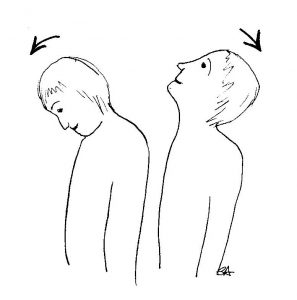
While sitting comfortably, back straight, head up and shoulders down gently tip your head forward onto your chest and let it bounce up and down a few times. You may feel some tightness but if it is painful back off and do it more gently. Then tip you head back as far as is comfortable and again bounce it gently a few times. Bring your head back to a neutral position.
2. Turn
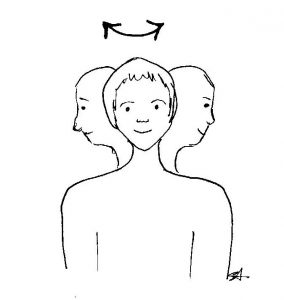
Now turn your head to look over one shoulder. Go as far as is comfortable and then bounce backwards and forwards a few times feeling a little tightness perhaps but not causing any pain. Keep your gaze horizontal, do not dip your head down or raise it. Repeat the same movement looking over the other shoulder. Bring your head back to a neutral position.
3. Tilt
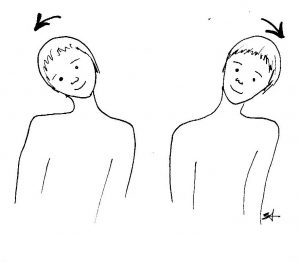
Bring you head back to a neutral position. Bend your head to one side with your ear toward your shoulder and again bounce your head a few times. Repeat the exercise in the opposite direction.
4. Shrug
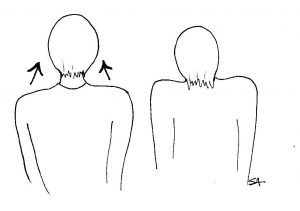
Now for an extra exercise. Shrug your shoulders up towards your ears. Hold for about 10 seconds then relax. Repeat that movement a few times.
B. Relax Tension in Back Muscles
Perhaps your tensions are in your lower back. That is especially likely if you have had to sit a lot. The last thing you need is a lie down, to slump in an armchair or a rest! You need some gentle exercise.
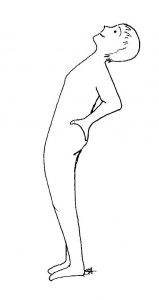
Stand with your feet shoulder-width apart and your hands on the small of your back. Now stretch backwards without falling over or feeling pain. Relax after a few moments then repeat it a few times.
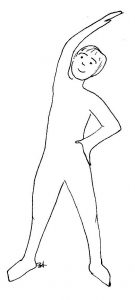
Now put your hands on your hips and lean to one side as far as you can comfortably go, then push it a little further, release and do it again a few times. You may prefer to keep the hand on the side you are leaning toward on your hip but raise the other hand above your head. Do whichever you find most comfortable, or less of an embarrassment, especially if you are in public such as standing in the aisle of a plane or train. Then do the same leaning to the opposite side.
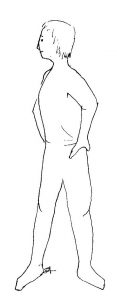
Now do similar movements but this time twisting your body to one side while keeping your feet still. Then repeat in the opposite direction.
Tension in legs and arms are not usually much of a problem in stress terms but to complete the cycle do similar stretching exercises for your thighs and calves, shoulders and arms – but going for a walk is even better!
Keep doing these regularly, even every day – especially the neck exercises – so when you are stressed you will then be prepared and can do the exercises at the first sign of tension developing even before you realise you are stressed!
C. Control breathing
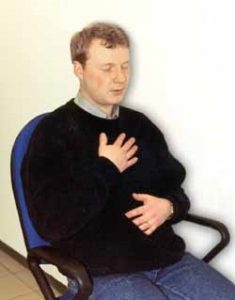
When you are stressed you tend to breathe faster and shallower. This is partly due to tension in the ‘breathing’ muscles in your chest wall and diaphragm and can develop into a panic reaction. While sitting comfortably breathe in deeply and slowly; hold it for a few seconds then breathe out slowly. Repeat the process a few times and do it whenever you feel tense. Thinking about your breathing takes your mind off your troubles. It eases the physical effects of stress and gives a few moments to relax. This pause gives you a moment to collect yourself, step back from the immediate stress, straighten your mind and begin to think that little bit more clearly. It can make all the difference to your sense of control. If you feel dizzy or faint, stop straightaway as you are over-breathing and are losing too much carbon dioxide. You will recover within a few seconds.
Let me illustrate how this works with a story. It is about a trivial matter but shows how powerful stress can be.
Years ago Alf and Penny were learning about computers at a government sponsored course. Penny was ahead and had passed the latest exam a few days earlier without any difficulty. Alf had just started the exam when he realised there was a question he could not answer. He finished the rest of the exam and came back to it. His mind had gone blank. This was an important question and if he did not answer he might fail, and his wife had passed! (OK chauvinistic, I know, but when stressed we revert to our basic traditional, culturally imbued, learned-in-childhood behavioural habits). He panicked. He was hunched over the desk, sweating, getting breathless, crossing and uncrossing his legs, checking the time on his watch every 10 seconds. Failed! Failed! Failed! After a few minutes, he pulled himself together. This is stupid, he said to himself. He made himself sit back and sit with his feet apart. He put his watch in his pocket and began to breathe gently and slowly. He knew about stress relieving exercises so did the neck exercises and within seconds felt himself relaxing. He stopped fretting and began to think more clearly. His eye wandered over the computer screen and he noticed the help button. Of course! With computers, there is always an alternative way to getting where one wants to go. Within seconds he had the information he needed to get back on track. Answered the question. Passed!
Do you see how this works? It is not dealing with the stress itself but with how stress affects you – the symptoms of stress. If you can calm down and relax physically you will be in a better position to think straight and work out what you need to do to sort out your problems.
Do you have a story to share about how you have found relaxing has helped you see things more clearly and respond more effectively to your immediate problems?
Click on the Response Button and share it.
